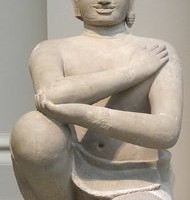-
The Met To Return Two Pieces Of Ancient Khmer Art To Cambodia
05/08/2013
 After months of negotiations between the Metropolitan Museum of Art and Cambodian officials, the Met has decided to return to Cambodia two 10th-century Khmer statues that had been improperly removed from the Koh Ker temple complex and then smuggled out of the country during the 1970s. The two sandstone statues, known as the Kneeling Attendants, had stood prominently at the entrance to the museum’s Southeast Asian galleries since 1994.
After months of negotiations between the Metropolitan Museum of Art and Cambodian officials, the Met has decided to return to Cambodia two 10th-century Khmer statues that had been improperly removed from the Koh Ker temple complex and then smuggled out of the country during the 1970s. The two sandstone statues, known as the Kneeling Attendants, had stood prominently at the entrance to the museum’s Southeast Asian galleries since 1994.
The first Kneeling Attendant was donated in 1987 by Spink & Son, a London auction house, and Khmer art collector, Douglas A. J. Latchford. The second head was donated by Raymond G. and Milla Louise Handley in 1989, who had purchased it at Spink. In 1992 Latchford gave the Met two torsos belonging to the statues, and in 1993, the heads and bodies were reattached by museum conservators. Among the evidence that the statues had been looted were photographs showing the statues’ broken-off bases, left behind at the temple site, and witness statements indicating the statues remained intact as recently as 1970.
This is not the first time the Met has been embroiled in disputes over cultural objects. In fact, over the years, the museum has returned many items with questionable provenances to their countries of origin, including 19 pieces from King Tutankhamun’s tomb, the Euphronios krater, and a 10th-century head of Shiva looted from Angkor.
The Met’s decision to return the Kneeling Attendants reflects the increasing sensitivity of American museums to claims by foreign countries for the return of cultural artifacts. While many objects do not have documentation showing precisely how they left their countries of origin, there is a growing movement by museums, prompted by scholars and the Association of Art Museum Directors, to examine the provenances of objects in their collections and to apply more rigorous standards of due diligence to new acquisitions.
The Met’s decision to return the works in this case should be applauded. As Tess Davis, a researcher on Cambodian antiquities with the Scottish Center for Crime and Justice Research in Glasgow has said, the Met’s repatriation of these statues should serve as an example for other museums that possess antiquities with dubious provenances, and represents “an opportunity to set the moral standard for the art world.”
Art Law Blog
